Rob Zombie’s ‘House of 1,000 Corpses’ Turns 20: An Oral History of a Bloody Cult Classic
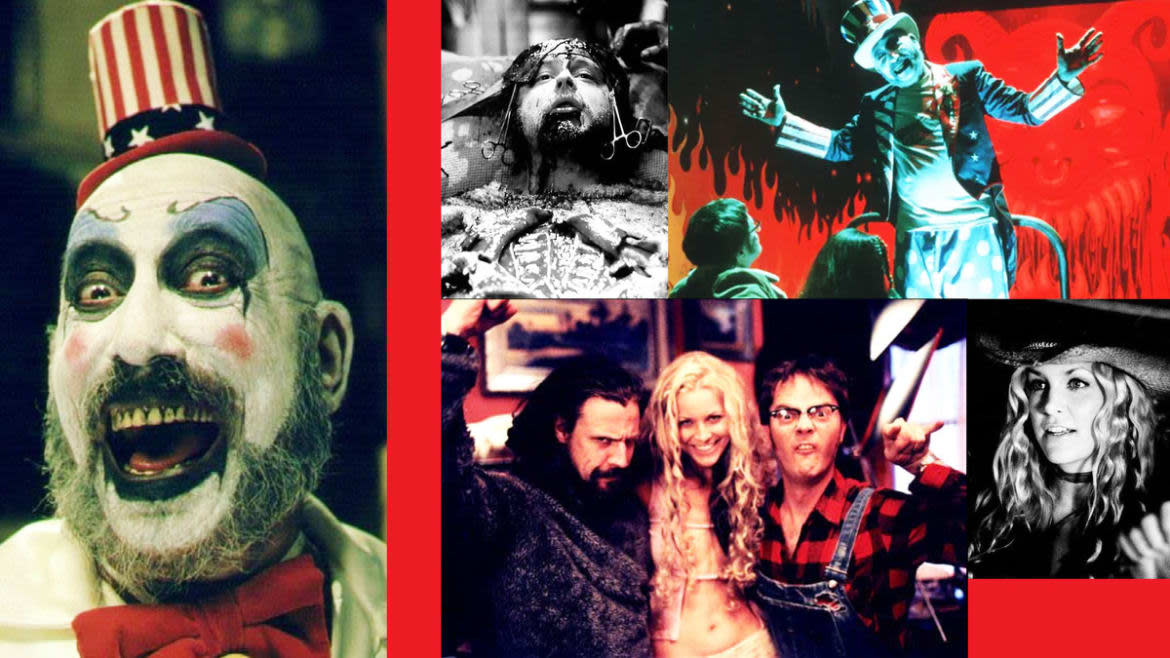
- Oops!Something went wrong.Please try again later.
- Oops!Something went wrong.Please try again later.
- Oops!Something went wrong.Please try again later.
It’s the year 2000, and you’re an unsuspecting tourist at Universal Studios.
You’re on the studio backlot tour, seated on one of those trams as it trundles up a peaceful residential-looking street. Your guide points out one of the houses. It’s seen better days (namely in 1982, when it served as a cheery brothel run by Dolly Parton) and looks decidedly sinister: ramshackle clapboards painted a sinister gray.
Suddenly, a man staggers out of the front door, covered in blood and wearing someone else’s skin. He leers and waves at your wide-eyed group.
More than 20 years later, the man, actor Bill Moseley, recalled to The Daily Beast’s Obsessed how the tour guide didn’t miss a beat, announcing, “‘And on your right, you’ll see Rob Zombie’s movie House of 1,000 Corpses in production.’”
This spring marks that movie’s 20th anniversary. A nasty little stink bomb of a grindhouse slasher, the “plot” of House of 1,000 Corpses, if it can be called that, concerns four kids (including a pre-Office Rainn Wilson) who get lost on the backroads of America while searching for a local legend named Dr. Satan. Instead of finding him, they’re captured by a psychotic family called the Fireflys, who—spoilers—brutally kill off the youngsters one by one.
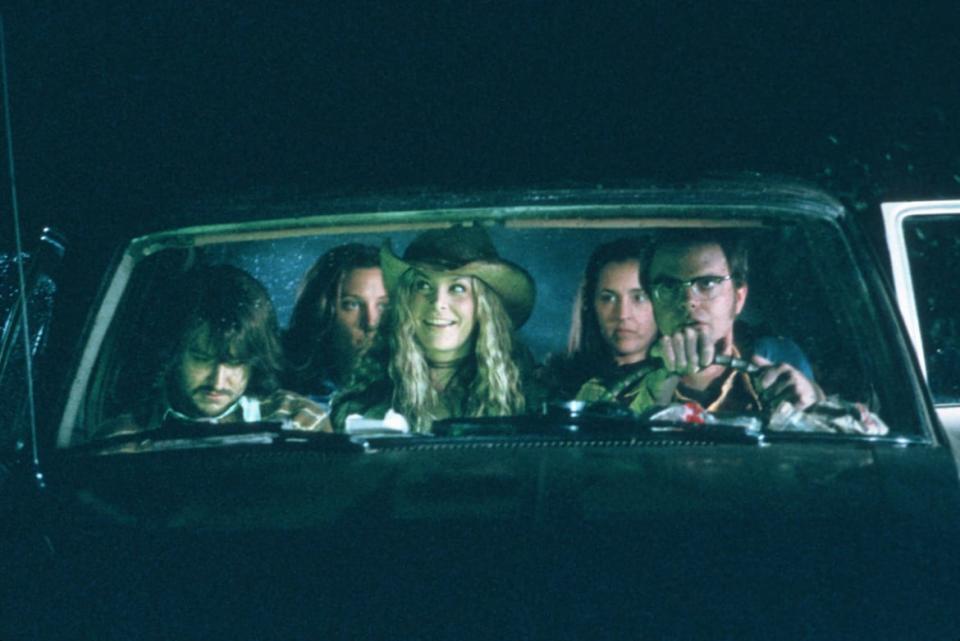
The cast of House of 1,000 Corpses.
Punctuated by bizarro cutaways and surreal sequences, House of 1,000 Corpses very nearly never saw the light of day, thanks largely to a procession of studio executives who believed they were punk rock enough to ride, only to clutch for their pearls at the last second. It finally hit theaters in 2003, though, much to the distaste of critics—and the delight of a small slice of the moviegoing public.
Keenan McClelland, who works at a comic book store when he isn’t broadcasting himself gaming, watching horror movies, or recording The Every Day is Halloween Podcast to his audience on Twitch, rushed to a midnight screening in his hometown of Orlando as soon as he caught wind of the movie’s release. An hour and a half later, he walked out on a cloud.
“I just wanted to shout it from the rooftops, like, ‘This is the future of horror!’” he said. “I couldn’t wait to see what else this shock rocker had in store for us.”
That diehard fanbase has only grown in the years since the advent of social media and the dawn of the streaming era. Several younger fans who spoke to The Daily Beast’s Obsessed professed to hunting down their own DVD copies after falling in love with it.
‘Evil Dead Rise’ Opens with a Perfectly Disgusting Throwback
“It was such an instant connection. You know when you realize that you and a director are on the same wavelength? I just got it, instantly,” said Eleanor Martin, a postgraduate film student in England. “I had to learn everything I could about it.”
House of 1,000 Corpses draws heavily from the horror canon that Zombie feasted on growing up in the sleepy town of Haverhill, Massachusetts, in the years before he went off to New York City to found White Zombie and become a heavy metal god.
His finished film was Texas Chainsaw Massacre but more gleeful and carnivalesque; it was The Rocky Horror Picture Show but more cramped and grotesque. It was the Marx Brothers and the Manson family chopped up and blitzed in a blender, then poured straight down your gullet as you’re held down by a late-night horror host from the 1950s and an MTV editor from the 1990s.
“I know that [Zombie] had the idea for Corpses while working on a haunted house, which really comes through,” Martin said. “It’s the movie equivalent of doing a haunted house.”
Zombie had just gone solo when Universal decided to give him a blank check and the run of their backlot. Riding high off the success of his latest album, Hellbilly Deluxe, he was designing a scare maze for the studio’s Halloween Horror Nights when an executive turned to him and asked if he had any movie ideas.
He improvised a pitch on the spot. The executive seemed to like it, so Zombie went home and started writing. He already had the title.
“The script wasn’t even spell-checked,” remembered Gregg Gibbs, House of 1,000 Corpses’ production designer. “He said he gave it to Universal. I don’t even think they read it. They gave him the green light.”
Gibbs, who had designed several of Zombie’s music videos for Hellbilly Deluxe, got a call about joining the movie’s crew in February 2000. Shortly after, he walked into Universal’s prop department and “took everything and just threw it everywhere.”
Every frame of House of 1,000 Corpses splits at the seams—crammed not just with ideas and influences, but just plain old stuff. “The sets were packed with junk. They were really densely decorated,” Gibbs said. When he couldn’t find the right pieces in the warehouse, he relied on a small army of his artist friends, building up a team that would eventually swell to 60 people. “We made homemade Halloween decorations and masks and sculptures and paintings.”
Fittingly, they also made a lot of corpses. “I think I made more than 200 fabricated corpses for the corpse hallway,” Gibbs said of one particularly eerie set that the movie’s final girl, Denise, must traverse. “Each one individually decorated and unique from the other.”
Assembling the 1,000 Corpses
When Bill Moseley, who was cast as the crazed and sadistic Firefly family member Otis B. Driftwood, arrived on set, he realized with delight that his director had “cherry-picked a lot of the actors who gave him and young brother a thrill when they were kids.”
Moseley himself was one of them, having already collected a number of horror credits, including The Texas Chainsaw Massacre 2, the Night of the Living Dead remake, and Army of Darkness. For Mama Firefly, Zombie turned to Karen Black of Easy Rider and Five Easy Pieces fame. Sid Haig, a cult film legend known for his work in Spider Baby and Foxy Brown, was tapped to play the gonzo clown Captain Spaulding.
Mixed in with this motley collection of Zombie’s favorite actors were his friends. He gave the role of squeaky psycho Baby Firefly to his then-girlfriend (now wife), Sheri Moon. Chris Hardwick, a buddy he’d met at the MTV Music Awards, was asked to play Jerry, one of the four kids, with Zombie telling him he’d written the part of a “loud, obnoxious asshole” specifically for him. “I immediately said yes,” Hardwick wrote on Facebook in 2017.
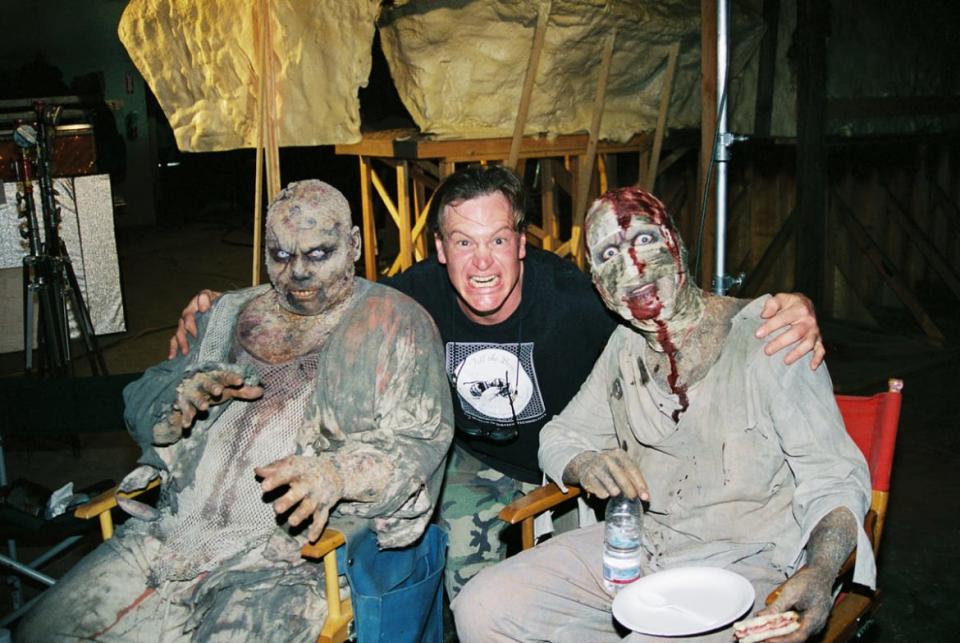
Production designer Gregg Gibbs on set with corpse zombies.
“Rob really has a great genius for picking the right people and putting them together,” Moseley said. “I just had a ball. I would kind of pinch myself every day.”
The movie mutated on the fly, the scenes mercury in Zombie’s hands as he showed up each morning brimming with new ideas—new pages for the cast to memorize, new sets for the crew to construct.
At one point, Gibbs was drafted to jump in front of the camera to play Dr. Wolfenstein, a horror-host character initially meant to be Zombie’s cameo. (He got into makeup on the day and decided that audiences would immediately recognize him, according to Gibbs. Zombie recast himself as Wolfenstein’s hairy assistant, a more heavily disguised role.)
Safety was an afterthought, with one scene calling for an actor to dodge a real ax wielded by another performer whose vision was severely compromised by his costume. “We just assumed she would get out of the way,” Zombie remarks on the film’s DVD commentary.
“It was kind of this crazy carnival going on at Universal in the backlot,” Gibbs said, adding that at night, the crew would climb up the hill “and party at the Psycho house.” Then they’d crash, wake up, and do it all over again.
By all accounts, it was the best time ever.
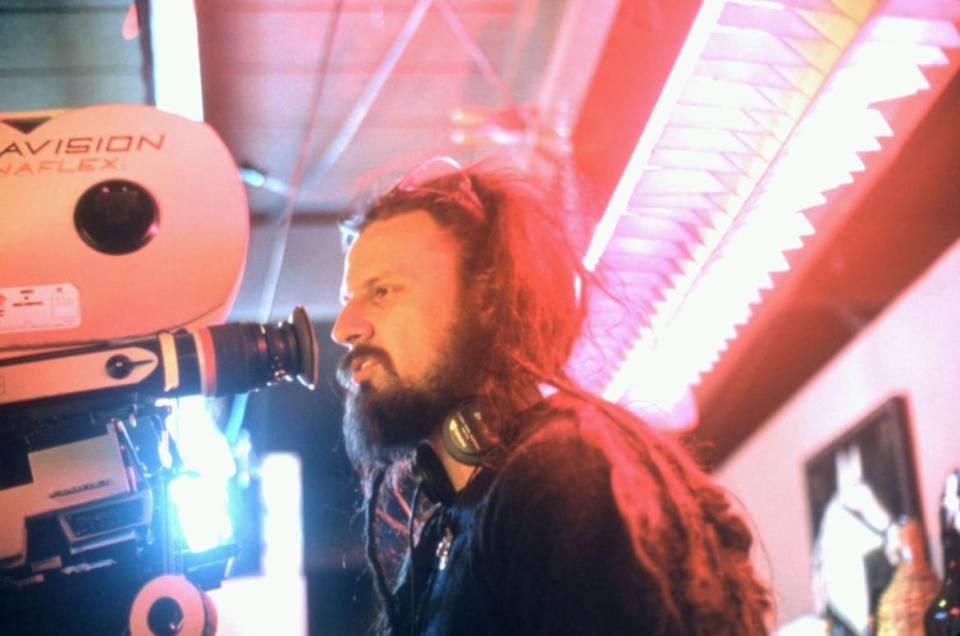
Rob Zombie on set of House of 1,000 Corpses.
Zombie, whose representatives declined to make him available for an interview, told The Guardian in 2003 that “the time while I was shooting was like the greatest experience I ever had. Right until the very end.”
“Then it all went kind of screwy.”
Facing Off With the Morality Police
Under threat as Congress and the Federal Trade Commission eyed the vulgarity, violence, and sexual content in Hollywood, Universal executives began to squirm. Then-Chairwoman Stacy Snider was dragged out to Capitol Hill to testify. The first event on her agenda back in Los Angeles, according to Zombie, was a test screening of House of 1,000 Corpses.
“She comes straight from the airport… and watches a bunch of kids screaming at the movie,” he told The Guardian. “There was one point I think sealed the deal—a scene where a cop is murdered, after a really long pause. In the pause, all these kids started screaming, ‘Kill him! Kill the fucking cop!’ At first I thought, ‘Yeah! People are really into it!’ Then I saw her face.”
Now terrified that House of 1,000 Corpses would be slapped with an NC-17 rating—a box-office kiss of death—the studio asked Zombie to tone the movie down. He refused, according to Moseley.
Ari Aster Answers All Your Questions About ‘Beau Is Afraid’
“There was a lot of political headwind; they wanted to play it safe. Understandably, they had an investment to protect,” he said. “Rob fought tooth and nail, said, ‘No way.’”
Instead of shelving House of 1,000 Corpses, Universal gave it back to Zombie. “The film is a significant accomplishment for Rob,” Snider explained delicately to Variety, “yet there is a visceral tone and intensity that we did not imagine from the printed page.”
Zombie tried to find his movie a new home, and after a misstep with MGM (which dropped him after he jokingly told Ben Affleck on-camera the studio had “no morals” for agreeing to distribute it), landed a deal with Lionsgate, then a fledgling company hungry for its own Blair Witch Project-style smash hit.
House of 1,000 Corpses hit theaters and landed in second place at the domestic box office in its first week, behind only Jack Nicholson’s Anger Management. “Lionsgate made back all their money the first day,” Zombie crowed to the A.V. Club.
Luckily, the intervening years had only sharpened House of 1,000 Corpses’ flavor. “It’s a pre-9/11 film, released to a post-9/11 audience, that somehow really handily preempts all these themes we had suddenly become obsessed with in our movies,” Martin said. Surveillance, captivity, revenge, paranoia, culture clash—it was all in there.
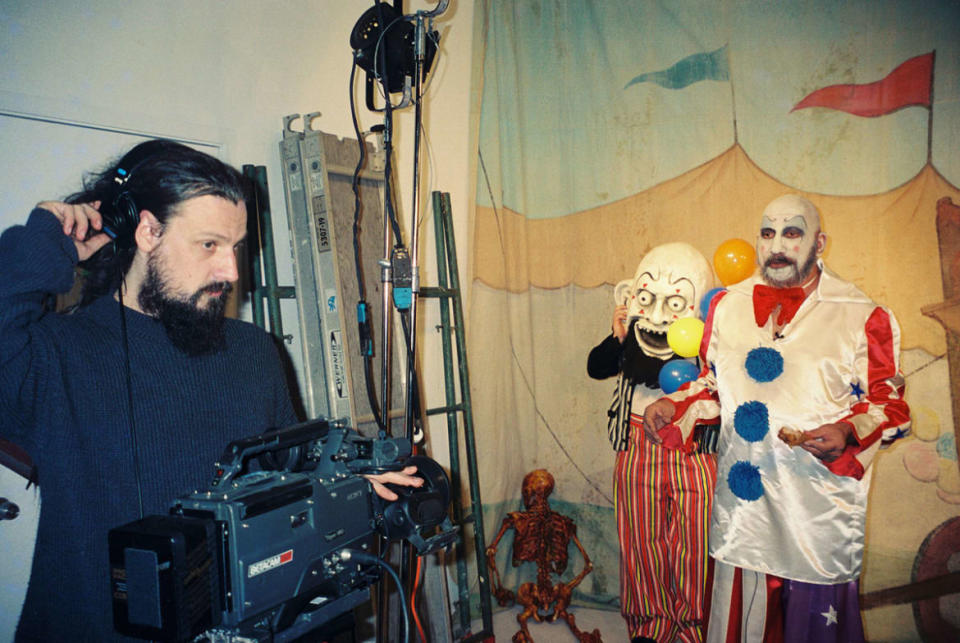
Director Rob Zombie shooting Sid Haig as Captain Spaulding.
“It hit the horror community at exactly the right time to make a splash and really resonate with people,” explained Taylor Manes, a friend of Martin’s and a podcaster who hosts The Final Girl Files. “And it’s gotten better with age. It’s so unapologetically yucky in that very early 2000s way, there’s now that nostalgia factor.”
Manes was introduced to House of 1,000 Corpses while playing Tubi roulette a few years ago, and was instantly drawn to how the movie reveled in its own wickedness. Talking about the Firefly family—though she just as easily could have been speaking about the people who made the movie—she explained, “This is a group that doesn’t give a shit what anybody thinks about them, and are so committed to each other, and to doing the thing that brings them happiness.” Then she paused.
“Unfortunately, that thing is murder, but like—they’re having a great time.”
That’s exactly why it appealed to McClelland, who went out and bought the DVD—“the very first one, where it was just a cardboard flip cover without a clasp”—as soon as he could. He quickly began marshaling people over to his apartment to hold screenings. When Zombie released a sequel, 2005’s The Devil’s Rejects, McClelland led a group of more than a dozen friends to the theater.
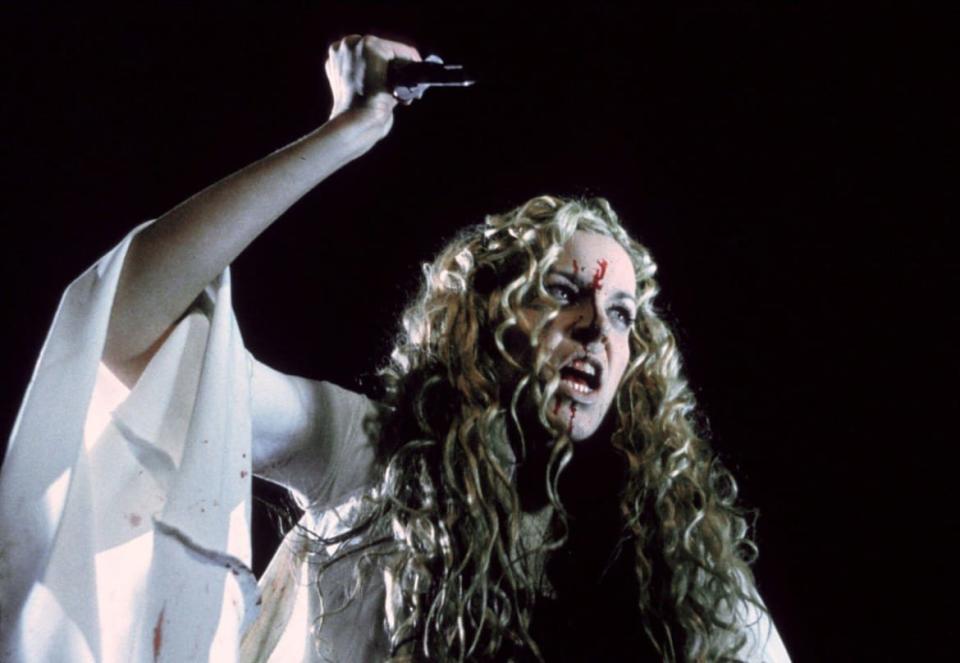
Sheri Moon Zombie in House of a 1,000 Corpses.
“They were like, ‘Keenan really loves this House of 1,000 Corpses thing. We have to see what this is all about,’” he said. “It was the best time.”
Despite the decline of physical media, that word-of-mouth culture has endured. “It’s very much one of those movies that I love to show people,” Manes explained. “Just recently, a friend told me that she’d never seen it. I was like, ‘We’re watching House of 1,000 Corpses. I’m going to strap you down Clockwork Orange-style if that’s how I have to make it happen.’”
Making a Cult Classic
Like other cult classics, House of 1,000 Corpses has also benefited from everyone being online all the time. “It’s gotten really big,” observed Cherry, a costume designer who cosplays as Baby Firefly, and once played her in a haunted house at Zombie’s annual Great American Nightmare scarefest. “Best job I’ve ever had,” she said.
Cherry came to House of 1,000 Corpses after her brother introduced her to Zombie’s music as a kid. “I remember even back when it first came out, people were like, ‘This movie sucks. It’s so stupid,’” she said. “I was like, ‘What are you talking about? This is the greatest thing I’ve ever seen!’ It was crazy, scary, trashy fun, and a little bit ahead of its time, I think.”
More people are catching on (including Universal, which used House of 1,000 Corpses as the basis for part of its annual Halloween Horror Nights in 2010, 2011, and 2019). Cherry also runs a server on the social messaging platform Discord that has accumulated more than 150 members, who gather to discuss and post about Zombie’s movies and other horror flicks like The Texas Chainsaw Massacre.
10 Years On, ‘The Evil Dead’ Reboot Has Become a Must-See
“Something about it just sticks in your mind,” she said. “Even for people who hate it. You’ll never forget the weirdness of House of 1,000 Corpses.”
The people who made the movie also continue to bang the drum for it. In the same 2017 Facebook post, Chris Hardwick wrote, “Horror was really different back then—kind of watered down—and Rob really wanted to bring back that gritty 70s super fucked up everyone-dies-for-being-in-the-wrong place films and I truly believe it inspired the next wave of horror.”
Others, like Moseley, Karen Black, and Sid Haig, spent years running what McClelland characterized as an “underground publicity tour” simply by going to horror conventions and signing autographs. McClelland, who estimated he goes to three or four cons a year himself, would see them frequently, set up behind booths and interacting with delighted fans.
“You could just tell that these guys were doing the groundwork for Corpses,” he said. “You’d see these lines get bigger and bigger and bigger over the years.”
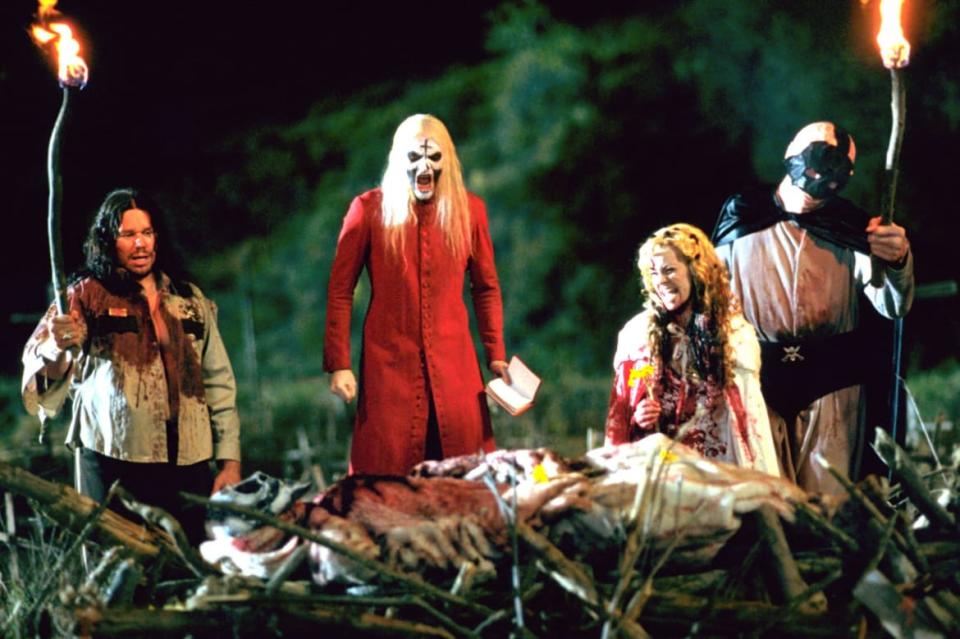
Chris Hardwick, Bill Moseley, and Sheri Moon in House of 1,000 Corpses
The explosion of the movie’s fanbase really hit actor Robert Allen Mukes, who played Rufus Firefly, for the first time a few years ago, when he signed an autograph for a 12-year-old girl. “I was like, ‘Oh my god. The parents are showing it to their kids, and the kids are telling their friends,’” he said.
Mukes goes to about 20 cons a year now, often dressed as Rufus in a grimy plaid shirt and filthy jeans. Frequently, to gas himself up before an appearance, he’ll watch House of 1,000 Corpses. Sometimes he’ll play it afterward, too.
“It’s kind of a good-luck thing, kind of a gratitude thing,” Mukes said. “Not that I’ll make it a big event with popcorn or anything, but I’ll throw it on as I’m packing or moving around.”
By his rough calculations, he’s getting close to having rewatched it 100 times. “So,” he added, laughing, “I guess I’m a super-fan of the movie too.”
Keep obsessing! Sign up for the Daily Beast’s Obsessed newsletter and follow us on Facebook, Twitter, Instagram and TikTok.
Get the Daily Beast's biggest scoops and scandals delivered right to your inbox. Sign up now.
Stay informed and gain unlimited access to the Daily Beast's unmatched reporting. Subscribe now.

